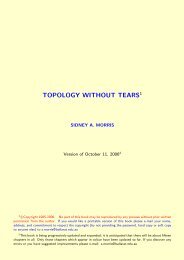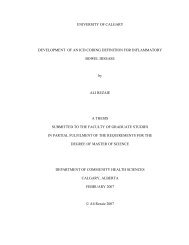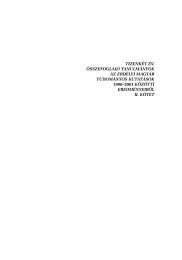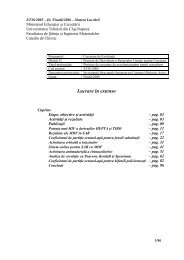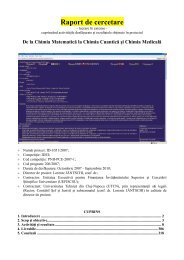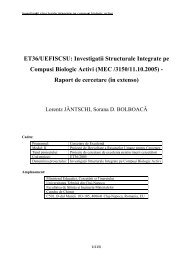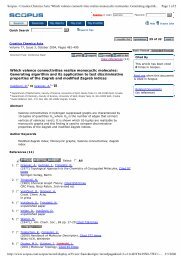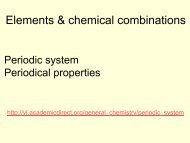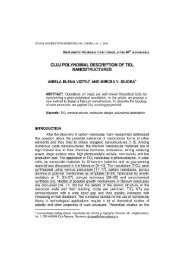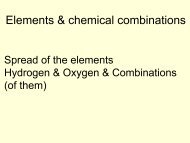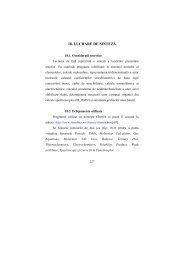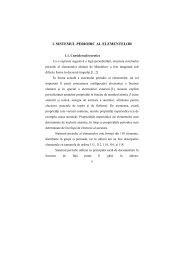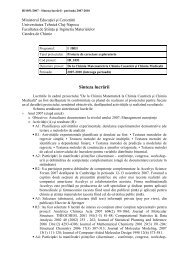Extraction and Planar Chromatographic Separation Techniques in the
Extraction and Planar Chromatographic Separation Techniques in the
Extraction and Planar Chromatographic Separation Techniques in the
Create successful ePaper yourself
Turn your PDF publications into a flip-book with our unique Google optimized e-Paper software.
30<br />
In this <strong>the</strong>sis <strong>the</strong> performance of <strong>the</strong> new prototype separation <strong>in</strong>strument ExtraChrom ® <strong>in</strong> <strong>the</strong><br />
isolation of constituents of various natural products was <strong>in</strong>vestigated. In addition to <strong>the</strong><br />
publications <strong>in</strong>cluded <strong>in</strong> this study, <strong>the</strong> suitability of ExtraChrom ® has been studied <strong>in</strong> <strong>the</strong><br />
isolation of antimicrobial <strong>and</strong> antioxidative compounds from oak bark (VOVK et al. 2003,<br />
ANDRENSEK et al. 2004). C-RPC fractionation of 840 mg of crude oak bark extract yielded<br />
6.7 mg of pure (+)-catech<strong>in</strong> <strong>in</strong> one run. The advantages of <strong>the</strong> method were considered to be<br />
<strong>the</strong> easy <strong>and</strong> rapid fill<strong>in</strong>g of <strong>the</strong> planar column <strong>and</strong> <strong>the</strong> possibility to use adsorbent material of<br />
small particle size.<br />
6.3.2.Analytical RPC<br />
The analytical applications of RPC are not as numerous as preparative ones, although some<br />
results have been published on <strong>the</strong> topic. U-RPC separation of iridoid glycosides has been<br />
compared to TLC, HPTLC <strong>and</strong> OPLC, <strong>and</strong> <strong>the</strong> resolution was found to be better than with<br />
TLC <strong>and</strong> HPTLC methods (DALLENBACH-TOELKE et al. 1987). The best resolution was<br />
obta<strong>in</strong>ed us<strong>in</strong>g l<strong>in</strong>ear OPLC, but <strong>the</strong> U-RPC method was preferred when a large number of<br />
samples had to be analyzed. VUORELA et al. (1988a) achieved a good separation of six ma<strong>in</strong><br />
coumar<strong>in</strong>s isolated from <strong>the</strong> roots of Peucedanum palustre (L.) Moench us<strong>in</strong>g U-RPC <strong>and</strong><br />
concluded that radial U-RPC yielded better results than l<strong>in</strong>ear elution. In <strong>the</strong> field of<br />
enantiomeric separations, U-RPC has been found suitable for <strong>the</strong> quantitative analysis of<br />
glycyl-D, L-val<strong>in</strong>e <strong>and</strong> D, L-α-methylser<strong>in</strong>e on chiral plates (NYIREDY et al. 1989). When<br />
compar<strong>in</strong>g HPTLC, OPLC <strong>and</strong> U-RPC <strong>in</strong> <strong>the</strong> separation of ergot alkaloids, BOTZ et al.<br />
(1990b) found U-RPC to be <strong>the</strong> most favorable method because, due to <strong>the</strong> presence of a<br />
certa<strong>in</strong> amount of vapor space, <strong>the</strong> multi-front effect does not occur. BOTZ <strong>and</strong> colleagues<br />
also <strong>in</strong>vestigated <strong>the</strong> applicability of Empore TLC sheets <strong>in</strong> forced-flow chromatography<br />
(1990c). The sheets, which are prepared from silica entrapped <strong>in</strong> a an <strong>in</strong>ert matrix of<br />
polytetrafluoroethylene microfibrils, were found to be unsuitable for M-RPC because of <strong>the</strong>ir<br />
distortion due to <strong>the</strong> applied centrifugal force. However, when U-RPC was used it was<br />
possible to achieve <strong>the</strong> optimum flow rate, thus lead<strong>in</strong>g to rapid separations with good<br />
resolutions. In <strong>the</strong> analysis of oak bark extract us<strong>in</strong>g <strong>the</strong> ExtraChrom ® <strong>in</strong>strument <strong>in</strong> U-RPC<br />
mode, (+)-catech<strong>in</strong> <strong>and</strong> (–)-epicatech<strong>in</strong> have been successfully separated on a cellulose layer<br />
us<strong>in</strong>g water as develop<strong>in</strong>g solvent (VOVK et al. 2003). The most significant advantages of <strong>the</strong><br />
method were concluded to be <strong>the</strong> possibility to use normal, commercially available TLC<br />
plates, <strong>the</strong> adjustable vapor phase, <strong>and</strong> <strong>the</strong> possibility of mobile phase optimization us<strong>in</strong>g<br />
conventional capillary-driven TLC.<br />
6.4. Medium pressure liquid chromatography (MPLC)<br />
MPLC is one variant of pressure liquid chromatography as opposed to conventional gravitydriven<br />
column chromatography (HOSTETTMANN et al. 1998). The application of pressure<br />
to force <strong>the</strong> mobile phase through <strong>the</strong> column has two effects: first of all it <strong>in</strong>creases <strong>the</strong> flow<br />
rate of <strong>the</strong> eluent lead<strong>in</strong>g to faster separations, <strong>and</strong> secondly pack<strong>in</strong>g material of f<strong>in</strong>er particle<br />
size can be used, thus giv<strong>in</strong>g higher resolution. The different preparative pressure liquid



